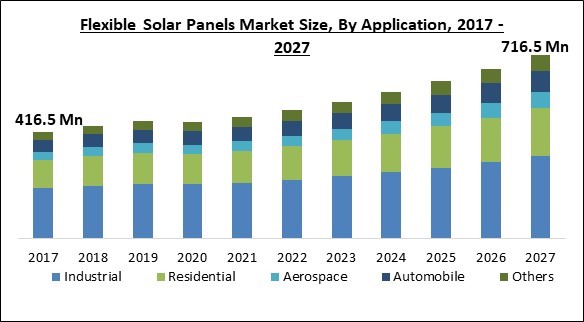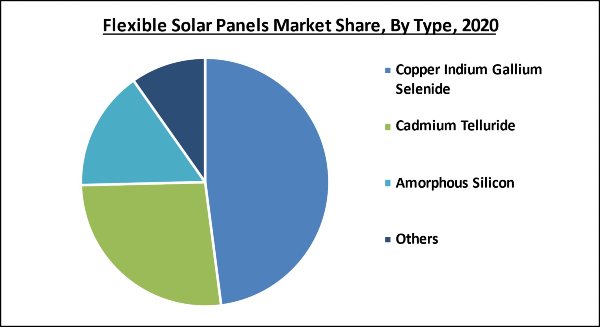The Global Flexible Solar Panels Market size is expected to reach $716.5 million by 2027, rising at a market growth of 7.2% CAGR during the forecast period.
Thin-film solar cells, also known as flexible solar panels, are second-generation solar cells that are formed by layering many thin films of photovoltaic material on a metal, glass, or plastic foundation. This method produces a substantially thinner product than standard polycrystalline or monocrystalline solar panels. In comparison to traditional solar panels, they are more flexible and lighter, which means that the roof simply needs to support a relatively lighter infrastructure that does not necessitate racks. This lowers the cost of production and installation.
As the unit of measurement to confirm the growth of civilization and a comfortable living environment for people, energy plays a major part in the development of numerous industries. The rapid advancement of technology and the conversion of most fuel-powered equipment to electrical power has raised the demand for clean energy resources.
For instance, the European Union launched a "green deal" scheme in order to access the massive solar roof potential of the European region in order to meet its carbon emission targets by 2050. A data center in Mumbai features one of the biggest buildings integrated with vertical solar PV systems in the world, with a capacity of over 1MW and a facade area of over 5000 square feet.
Photovoltaic (PV) devices turn sunlight directly into electricity. Photovoltaic cells of various sorts are essential components of a PV power system, also called solar cells. These components are integrated and encapsulated to produce a photovoltaic module, which is a mounting structure for grid-connected and off-grid solar panels. Solar energy is also renewable, which aids countries in achieving their policy objectives for reliable, secure, and inexpensive energy, as well as providing power access with less price volatility and promoting social and economic growth.

The outbreak of the COVID-19 pandemic has substantially devastated economies across the world. Due to the pandemic, various businesses, irrespective of their sizes, were severely demolished. In addition, various governments across the world were forced to impose lockdown in their countries in order to regulate the spread of the COVID-19 infection. Moreover, various countries enforced travel restrictions as well as trade limitations, due to which, the worldwide supply chain was considerably disrupted. The COVID-19 pandemic also had a negative impact on the flexible solar panels market. It had a significant impact on energy systems across the world, as a major reduction in investments was observed. Moreover, production facilities of flexible solar panels were shut, which substantially halted the production of these solar panels.
Flexible solar panels have a number of advantages over traditional solar panels. They can be mounted on low-load supporting roofs that would. The lack of structural elements such as ballasts, or roof penetrations makes installation easier and lowers labor costs. Flexible Thin-Film Applications that are popular due to their toughness and versatility, certain flexible solar panel technologies are particularly well suited to marine applications, such as aboard boats and yachts, where traditional solar panels can not be installed. In addition, there is also a type of ultra-thin film solar panel that can be bent as much as a thin sheet of plastic.
Flexible thin-film solar panels are prevailing in the market for a long duration. Amorphous silicon, a non-crystalline type of silicon, was used to create the first generation of flexible thin-film photovoltaic (PV) modules. While early generation a-Si thin-film modules were lightweight and flexible, they had a poor power output, with a power efficiency of only 5 to 6%, implying that only 5 to 6% of the sun's energy was turned into electricity. As a result, the power density was low, necessitating a huge surface to produce a power output comparable to crystalline silicon modules.
More than 73 million households in remote areas across the world get electricity from solar lanterns, solar home systems, and local solar-based micro-grids, instead of a conventional power grid. Off-grid systems and devices provide advanced and enhanced services to those who live in areas without access to centralized electrical grids, as well as helping to spread the usage of renewable energy.
Flexible solar panels are less efficient when compared to rigid panels. While rigid crystalline panels possess increased efficiency, ranging from 16% to 23%, flexible solar panels have efficiencies ranging from 10% to 17%. This is due to the fact that flexible panels' thin semiconductor films have less material to interact with sunlight. In addition, when compared to crystalline silicon in rigid panels, the semiconductor material utilized in flexible panels displays reduced efficiency.
Flexible solar panels can be easily bent and flexed to an extent. However, excessive bending and flexing might lead the solar cells to shatter. In addition, a solar cell can be cracked with just one bad strike, and cracked cells have a decreased efficiency. Rigid panels feature a glass overlay that can protect them from various elements.

Based on Type, the market is segmented into Copper Indium Gallium Selenide, Cadmium Telluride, Amorphous Silicon and Others. In 2020, the cadmium telluride segment registered a substantial revenue share of the flexible solar panel market. Thin solar panels are made of different photovoltaic materials than crystalline silicon solar panels. Cadmium telluride is an example of a thin-film solar panel. Thin-film solar panels are extremely thin because the photovoltaic material is printed onto a plastic surface rather than covered between a top and bottom protective layer like many other types of solar panels.
Based on Application, the market is segmented into Industrial, Residential, Aerospace, Automobile, and Others. In 2020, the industrial segment garnered the largest revenue share of the flexible solar panel market. Low-wattage equipment used in industries, such as lights, cameras, and others, are powered by flexible solar panels integrated into the building. The growing need for flexible solar panels is due to the rising demand for green energy to meet with the surge in the use of electricity-driven heavy-duty machinery and automation in the manufacturing industries.
| Report Attribute | Details |
|---|---|
| Market size value in 2020 | USD 453.8 Million |
| Market size forecast in 2027 | USD 716.5 Million |
| Base Year | 2020 |
| Historical Period | 2017 to 2019 |
| Forecast Period | 2021 to 2027 |
| Revenue Growth Rate | CAGR of 7.2% from 2021 to 2027 |
| Number of Pages | 156 |
| Number of Tables | 288 |
| Report coverage | Market Trends, Revenue Estimation and Forecast, Segmentation Analysis, Regional and Country Breakdown, Competitive Landscape, Companies Strategic Developments, Company Profiling |
| Segments covered | Type, Application, Region |
| Country scope | US, Canada, Mexico, Germany, UK, France, Russia, Spain, Italy, China, Japan, India, South Korea, Singapore, Malaysia, Brazil, Argentina, UAE, Saudi Arabia, South Africa, Nigeria |
| Growth Drivers |
|
| Restraints |
|
Based on Regions, the market is segmented into North America, Europe, Asia Pacific, and Latin America, Middle East & Africa. In 2020, Asia-Pacific witnessed the largest revenue share of the flexible solar panel market. The increasing growth of this segment is owing to the increasing consumption of solar panels across the region. Moreover, the regional market is flourishing due to the increasing number of developments across countries like India and China.
Free Valuable Insights: Global Flexible Solar Panels Market size to reach USD 716.5 Million by 2027
The market research report covers the analysis of key stake holders of the market. Key companies profiled in the report include Hanergy Holding Group Ltd., Enecom Srl, Flisom AG, PowerFilm Solar, Inc., SoloPower Systems, Inc., Solbian Energie Alternative Srl, Sun Harmonics co. ltd., Jinko Solar Holding Co., Ltd., Trina Solar Co., Ltd., and JA Solar Holdings Co., Ltd.
By Type
By Application
By Geography
The flexible solar panels market size is projected to reach USD 716.5 million by 2027.
Increasing applications of flexible solar panels in various verticals are driving the market in coming years, however, less effective and more fragile in comparison to rigid solar panels limited the growth of the market.
Hanergy Holding Group Ltd., Enecom Srl, Flisom AG, PowerFilm Solar, Inc., SoloPower Systems, Inc., Solbian Energie Alternative Srl, Sun Harmonics co. ltd., Jinko Solar Holding Co., Ltd., Trina Solar Co., Ltd., and JA Solar Holdings Co., Ltd.
The Residential segment shows high growth rate of 7.3% during (2021 - 2027).
The Asia Pacific is fastest growing region in the Global Flexible Solar Panels Market by Region in 2020, and would continue to be a dominant market till 2027.
Our team of dedicated experts can provide you with attractive expansion opportunities for your business.

